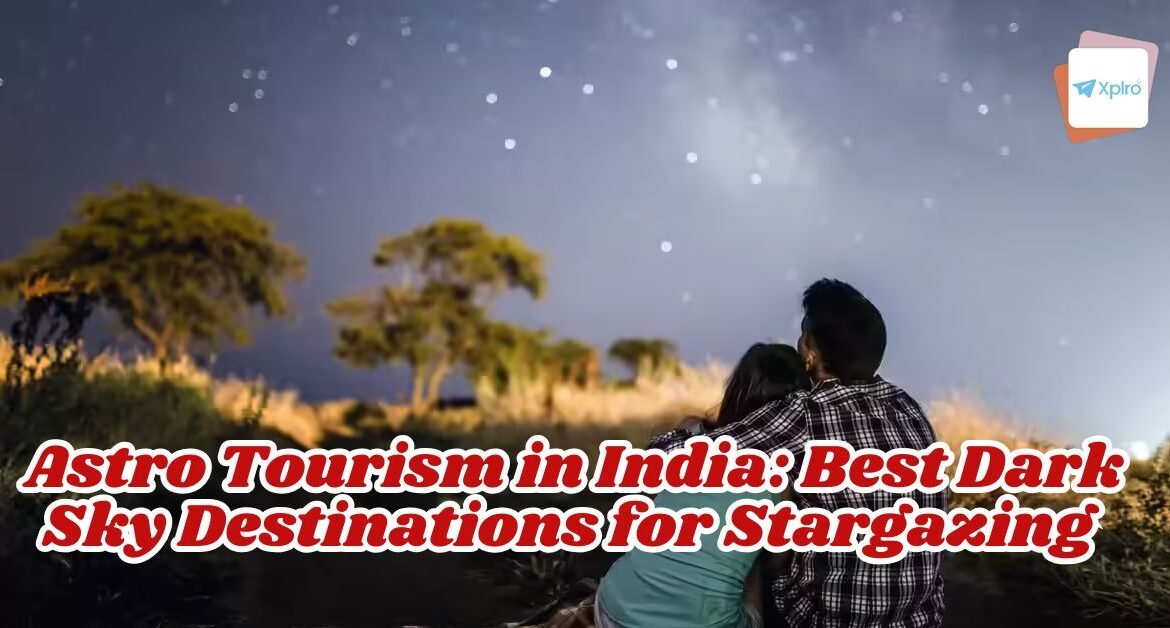Astro Tourism in India is becoming one of the fastest-growing travel trends, with more travelers seeking clean night skies, dark sky parks, and unforgettable Milky Way views. From Ladakh’s high-altitude desert landscapes to the remote valleys of the Northeast, India offers some of the world’s most stunning natural stargazing locations. This blog explores the best dark sky destinations for astro tourism in India in 2026, including certified dark sky reserves, top astro camps, and secret night-sky viewing spots perfect for beginners and enthusiasts.
In 2026, India’s astro tourism boom is expected to grow even bigger, thanks to new dark sky conservation zones, government-backed reserves, and community-led initiatives that protect the night sky from light pollution. Destinations like Hanle Dark Sky Reserve in Ladakh, Spiti Valley in Himachal, Kutch in Gujarat, and Coorg in Karnataka are becoming global hotspots for astrophotography, meteor shower watching, and telescope-based sky tours.
Introduction: The Rise of Astro Tourism
Astro tourism, also known as dark sky tourism, is one of the fastest-growing travel trends worldwide. In India, where diverse landscapes meet rich cultural heritage, the fascination with the cosmos has found a new home. As urbanization spreads and light pollution increases, travelers are seeking remote destinations where the Milky Way, constellations, and meteor showers can be seen in their pristine glory.
By 2026, India has positioned itself as a global astro tourism hub, thanks to initiatives like the Hanle Dark Sky Reserve in Ladakh, observatories in Karnataka and Uttarakhand, and eco-tourism projects that combine astronomy with sustainable travel.
This blog explores the best dark sky destinations in India for stargazing in 2026, along with travel tips, cultural insights, and practical guides to help astro enthusiasts plan unforgettable journeys.
Why Astro Tourism Matters in 2026
- Escape from Light Pollution: With 80% of the world’s population unable to see the Milky Way due to city lights, India’s remote regions offer rare clarity.
- Science Meets Travel: Astro tourism blends adventure with education, allowing travelers to learn about constellations, planets, and cosmic phenomena.
- Sustainable Tourism: Dark sky reserves promote eco-friendly travel, encouraging minimal energy use and conservation of fragile ecosystems.
- Unique Experiences: From camping under the stars in Ladakh to watching meteor showers in Gujarat, astro tourism offers experiences beyond traditional sightseeing.
Top Dark Sky Destinations in India (2026)
1. Hanle Dark Sky Reserve, Ladakh

Why Visit: India’s first certified dark sky reserve, located at 4,500 meters above sea level.
Highlights:
- Crystal-clear skies with minimal atmospheric disturbance.
- Indian Astronomical Observatory, one of the world’s highest observatories.
- Perfect for astrophotography and telescope-based stargazing.
- Best Time: May to September.
- Travel Tip: Carry oxygen support if sensitive to high altitudes.
2. Spiti Valley, Himachal Pradesh

Why Visit: Remote Himalayan desert with minimal population and pollution.
Highlights:
- Stargazing camps in Kaza and Kibber.
- Night sky photography workshops.
- Combine with cultural exploration of monasteries.
- Best Time: June to October.
3. Rann of Kutch, Gujarat

Why Visit: Famous for the Rann Utsav, but equally stunning for stargazing.
Highlights:
- Flat salt desert offers unobstructed 360° sky views.
- Meteor showers visible during winter months.
- Cultural blend of folk music and astronomy.
- Best Time: November to February.
4. Pench Tiger Reserve, Madhya Pradesh

Why Visit: Recently recognized as a dark sky park.
Highlights:
- Stargazing combined with wildlife safaris.
- Astronomy camps organized by eco-tourism groups.
- Family-friendly destination with guided tours.
- Best Time: October to March.
5. Neil Island, Andaman & Nicobar Islands

Why Visit: Remote island with pristine skies and tropical charm.
Highlights:
- Stargazing on beaches with zero light pollution.
- Combine with scuba diving and marine exploration.
- Ideal for honeymooners and families.
- Best Time: December to April.
6. Jaisalmer, Rajasthan

Why Visit: Desert landscapes provide clear skies and magical backdrops.
Highlights:
- Stargazing from sand dunes.
- Astronomy-themed desert camps.
- Blend of Rajput culture and cosmic exploration.
- Best Time: October to March.
7. Emerging Spots for 2026 – Astro Tourism in India

- Nubra Valley, Ladakh – Remote Himalayan skies.
- Coorg Observatory, Karnataka – Educational astro tourism.
- Mukteshwar & Kausani, Uttarakhand – Himalayan observatories for families.
Travel Tips for Astro Tourism in India
- Local Culture: Respect traditions while exploring remote villages.
- Gear Up: Carry telescopes, binoculars, and DSLR cameras.
- Apps & Guides: Use stargazing apps like SkySafari or Stellarium.
- Responsible Tourism: Avoid campfires and artificial lights.
- Health Precautions: High-altitude destinations require acclimatization.
Conclusion
Astro Tourism in India is entering its golden era, and 2026 is shaping up to be the best year yet for stargazing enthusiasts. With new dark sky reserves, improved accessibility, and rising interest in night-sky travel, India now offers some of the world’s most breathtaking celestial viewing experiences. From the crystal-clear Himalayan skies of Hanle and Spiti to the serene landscapes of Kutch and Coorg, each destination brings travellers closer to the Milky Way, meteor showers, and unforgettable cosmic wonders.
As light pollution awareness grows, more travellers are choosing remote, sustainable, and nature-driven experiences—making astro tourism one of India’s most exciting emerging trends. Whether you’re an amateur skywatcher, a serious astrophotographer, or simply someone who wants to experience the magic of a star-filled sky, these best dark sky destinations in India offer something extraordinary.
FAQs
1. What is astro tourism?
Astro tourism is travel focused on stargazing, astronomy, and celestial experiences, often in dark sky reserves or remote areas with minimal light pollution.
2. Why is astro tourism growing in India?
India’s diverse landscapes, government-backed observatories, and initiatives like the Hanle Dark Sky Reserve have made it a global astro tourism hub.
3. Which is India’s first dark sky reserve?
The Hanle Dark Sky Reserve in Ladakh, established in 2022, is India’s first certified dark sky reserve.
4. What are the best astro tourism destinations in India?
Top destinations include Hanle (Ladakh), Spiti Valley (Himachal Pradesh), Rann of Kutch (Gujarat), Pench Tiger Reserve (Madhya Pradesh), Neil Island (Andaman), and Jaisalmer (Rajasthan).
5. When is the best time for stargazing in India?
Winter months (October–March) offer the clearest skies, while Ladakh and Spiti are best in summer (May–September).
6. Can families enjoy astro tourism?
Yes, destinations like Pench Tiger Reserve and Uttarakhand observatories are family-friendly with guided tours and safe camps.
7. What equipment is needed for stargazing?
Basic gear includes binoculars, telescopes, DSLR cameras, and stargazing apps like Stellarium or SkySafari.
8. Are there astro festivals in India?
Yes, events like Astro Festival (Ladakh), Corbett Dark Sky Conclave, and Nakshatra Sabha series attract enthusiasts.
9. Is astro tourism eco-friendly?
Dark sky reserves promote sustainable tourism by reducing artificial lighting and conserving fragile ecosystems.
10. Can I see the Milky Way in India?
Yes, in remote destinations like Hanle, Spiti, and Rann of Kutch, the Milky Way is visible with the naked eye.
11. Are there observatories open to tourists?
Yes, the Indian Astronomical Observatory (Hanle), Coorg Observatory (Karnataka), and Mukteshwar Observatory (Uttarakhand) welcome visitors.
12. What cultural experiences combine with astro tourism?
Destinations like Rann of Kutch and Jaisalmer blend stargazing with folk music, desert camps, and local traditions.
13. Is astro tourism safe at high altitudes?
Yes, but travelers should acclimatize and carry oxygen support in Ladakh and Spiti.
14. Are there guided astro tours in India?
Yes, companies like Starscapes and local eco-tourism groups offer guided stargazing tours.
15. What are the best meteor shower viewing spots?
The Rann of Kutch, Ladakh, and Spiti Valley are ideal for meteor showers due to clear horizons.
16. Can astro tourism be combined with wildlife safaris?
Yes, Pench Tiger Reserve offers stargazing alongside tiger safaris.
17. Are there astro tourism packages in India?
Yes, curated packages include stargazing camps, photography workshops, and observatory visits.
18. How does India compare globally in astro tourism?
India’s Hanle Dark Sky Reserve ranks among the world’s highest observatories, making it globally competitive.
19. What precautions should astro tourists take?
Carry warm clothing, altitude medication, and avoid artificial lights during stargazing.
20. What is the future of astro tourism in India?
By 2026, India is expanding dark sky reserves, astro festivals, and educational observatories, making it a leader in cosmic tourism.




